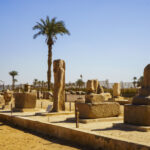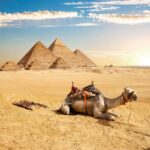At the end of 2020, we wrote a first-time visitor’s guide to visiting Karnak. While this guide has helped people learn more about this incredible temple complex, we know we can do even more! While many people travel to Egypt to see the pyramids, it’s often Karnak that makes the biggest impression. This extraordinary cornucopia of temples, obelisks, and statues is so large that it can sometimes take a few visits before you can truly say you’ve seen everything. And even then, we are always discovering new sights and wonders on our repeated visits with tour groups. If this guide whets your appetite and you’d like to know more, please feel free to get in touch.
What Exactly is Karnak?
While everyone appreciates what the Pyramids of Giza are, many people who have not visited are a little confused about the nature of Karnak. Well, any confusion is entirely justified as the pictures of Karnak are all so varied that it’s very tricky to get a clear idea of what the entire area actually consists of. Put simply, Karnak is a collection of quite a few wonderful ancient Egyptian things that were built over a period of just over one thousand years. There are several temples, statues of sphinxes and gods, huge obelisks, columns, and more. This is why pictures of Karnak can be a little hard to wrap your head around: it feels as though you’re seeing hundreds of different things.
While there is a sort of artistic cohesion, the form and function of the various structures changes considerably. The best way to understand how all of the structures fit together is to think of it as the most important religious centre for the ancient Egyptians. However, to understand what exactly Karnak is involves understanding what it used to be, delving into its rich history…
The History of Karnak
The story of Karnak begins with the rise of Thebes as the capital of the unified Ancient Egypt during the Eighteenth Dynasty of Egypt. This dynasty is often regarded as the first dynasty of the ‘New Kingdom of Egypt’ as it was when Egypt was unified and was at the height of its power and influence. This era stretched between 1550 BC until 1290 BC, but Karnak’s popularity and significance lived on past this.
The Karnak Temple complex comprises four main areas: the Precinct of Amun-Re, the Precinct of Mut, the Precinct of Montu, and the Temple of Amenhotep IV. Let’s look at a little background and some highlights of two of the precincts, leaving the Precinct of Montu and the Temple of Amenhotep IV for another day.
The Precinct of Amun-Re
One of the most important parts of Karnak is the Precinct of Amun-Re. This is the largest precinct of the temple complex and it was built and adorned by almost every pharaoh during the 18th Dynasty, including many of the era’s most famous names, such as Ahmose I, Thutmose I, Akhenaten, Hatshepsut, and Tutankhamun. As you can tell from the name, the Precinct of Amun-Re is dedicated to Amun-Re, the king deity of Thebes. As Amun grew in popularity and significance, he was fused with Ra, the sun god, and this is why he is often referred to as Amun-Ra or Amun-Re. This god was considered to be the champion of poor or troubled people, so it’s easy to see why he became so popular, earning himself the biggest spot in Karnak. Within this precinct, you can look forward to a few of the following highlights:
Corridor of Sphinxes (pictured above) — This long row of sphinxes is in remarkable condition.
Temple of Ramesses III — This small temple houses well-preserved inscriptions of the king killing captives while Amun-Re watches.
The Obelisk of Hatshepsut — This is the second biggest of all Ancient’s Egypt’s obelisks, rising almost 30m tall. Made out of a single piece of pink granite, for many this is the most impressive part of the temple complex.
The Sacred Lake — This is one of the most striking sights in Karnak. The small, rectangular lake was used in the priests’ rituals. The best thing about the lake is that it is completely calm, allowing it to perfectly reflect many of Karnak’s structures (this makes for some incredible photography).
Precinct of Mut
This complex of structures was dedicated to Mut, the mother goddess. Amun-Re was the king, and Mut was his wife and queen. This part of Karnak was mostly built by Thutmose II and Thutmose III, with Amenhotep III contributing to the structure later. However, there is also some evidence that Hatshepsut had a large part to play in the building of the Precinct of Mut and that Thutmose went to efforts to erase her contributions. Mut was the Egyptian goddess of the sky, and she had three main symbols: the lioness, the crown of Uraeus, and the vulture. Within this precinct, you can look forward to a few of the following highlights:
The Mut Temple — While much of the temple has eroded, there is still a sense of the original building’s considerable size. The statues of the lion-headed goddess Sekhmet outside the Temple of Mut are in various degrees of disrepair, but some are in remarkably good condition.
The Contra Temple — Considering its great age, this small temple is in reasonably good condition.
Mut Precinct’s Own Sacred Lake — For even more impressive photographs, make sure to check out Mut’s own Sacred Lake. Unlike the other sacred lake in the Precinct of Amun-Ra, this one curves around the Temple of Mut.
That’s all we have time for today. Of course, there is a lot more to say about Karnak, but we’re writing short-and-sweet internet guides, not thick historical tomes! We sincerely hope that after reading this brief guide you’re more excited to visit Karnak than you were before. Please reach out if you have any questions, and browse our Agatha Christie Tours of Egypt if you’d like to explore Egypt through the eyes of one history’s greatest mystery writers.


